Abstract
The Atrial Fibrillation Follow-Up Investigation of Rhythm Management (AFFIRM) study concluded that rate control with anticoagulation was equivalent overall to rhythm control with cardioversion for long-term survival and that anticoagulation reduced the risk of stroke. We compared baseline and follow-up data for three ethnic groups: Caucasians (n=3,599), African Americans (n=265) and Hispanics (n=132). Caucasians were older and more likely male, African Americans were more likely female and hypertensive, and Hispanics had higher prevalence of cardiomyopathy. Survival was better for rate control than rhythm control in Caucasians, equivalent in African Americans and better for rhythm control in Hispanics. Outcomes may be influenced by differential baseline characteristics, but low numbers of African Americans and Hispanics warrant caution in data interpretation. BACKGROUND: The AFFIRM study compared a rate-control strategy to a rhythm-control strategy for the treatment of atrial fibrillation (AF) in patients at high risk for stroke or death. It concluded that the rhythm-control strategy offered no survival advantage, and it also confirmed the value of anticoagulation to prevent complications of AF. Data have not previously been available for specific racial ethnic populations. METHODS: We compared baseline and follow-up data for the patients randomized to rate-control versus rhythm-control in three population groups-Caucasian, African-American and Hispanic. RESULTS: Among 4,060 total patients, 3,599 were Caucasian, 265 were African-American and 132 were Hispanic. At baseline, Caucasians were older and had a higher percentage of males, normal ejection fractions, AF as their only cardiac diagnosis, a prior antiarrhythmic drug failure and less congestive heart failure. African Americans were more likely to be female, had more hypertension and qualified for the study with a first episode of AF, compared to Caucasians. Hispanics had more cardiomyopathy at baseline than Caucasians. Overall survival in Caucasians at five years for the rate-control and rhythm-control groups was 78.9% vs. 76.4%, respectively (p=0.04); for African Americans, 79.0% vs. 69.4% (p=0.22); and for Hispanics, 66.5% vs. 83.9% (p=0.01). Overall, survival was not different between the three populations. However, lower rates of event-free survival were recorded for Hispanics and for African Americans (p=0.0182). CONCLUSIONS: Different survival rates were found for rate-control versus rhythm-control in African-American and Hispanic patients, compared to Caucasian. These findings may be influenced by differences in baseline characteristics, but must be interpreted with caution because of the small sample sizes for African-American and Hispanic participants.
Full text
PDF
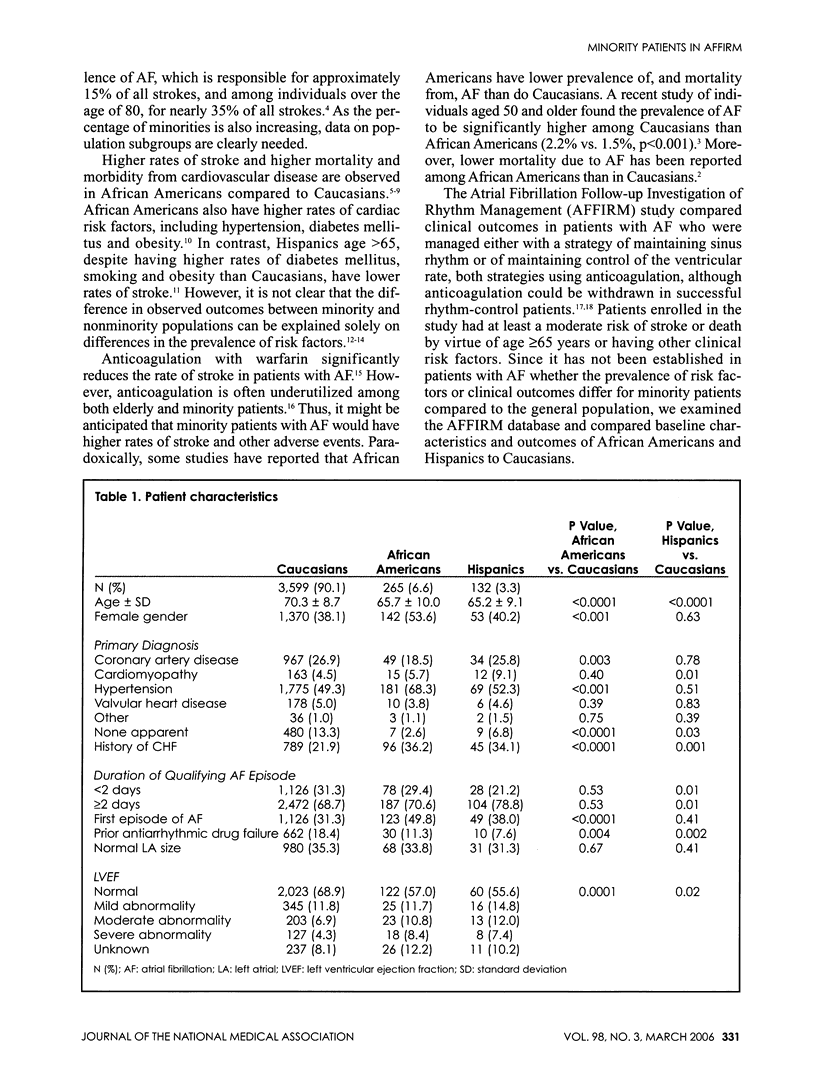
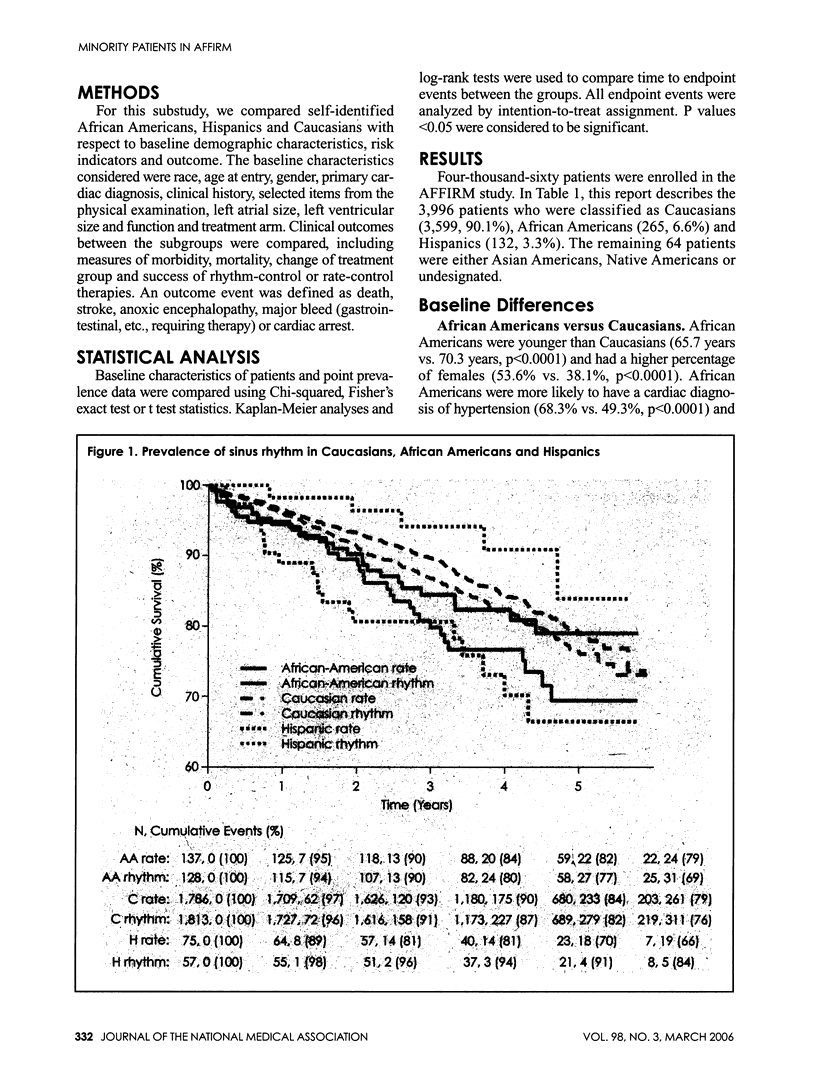
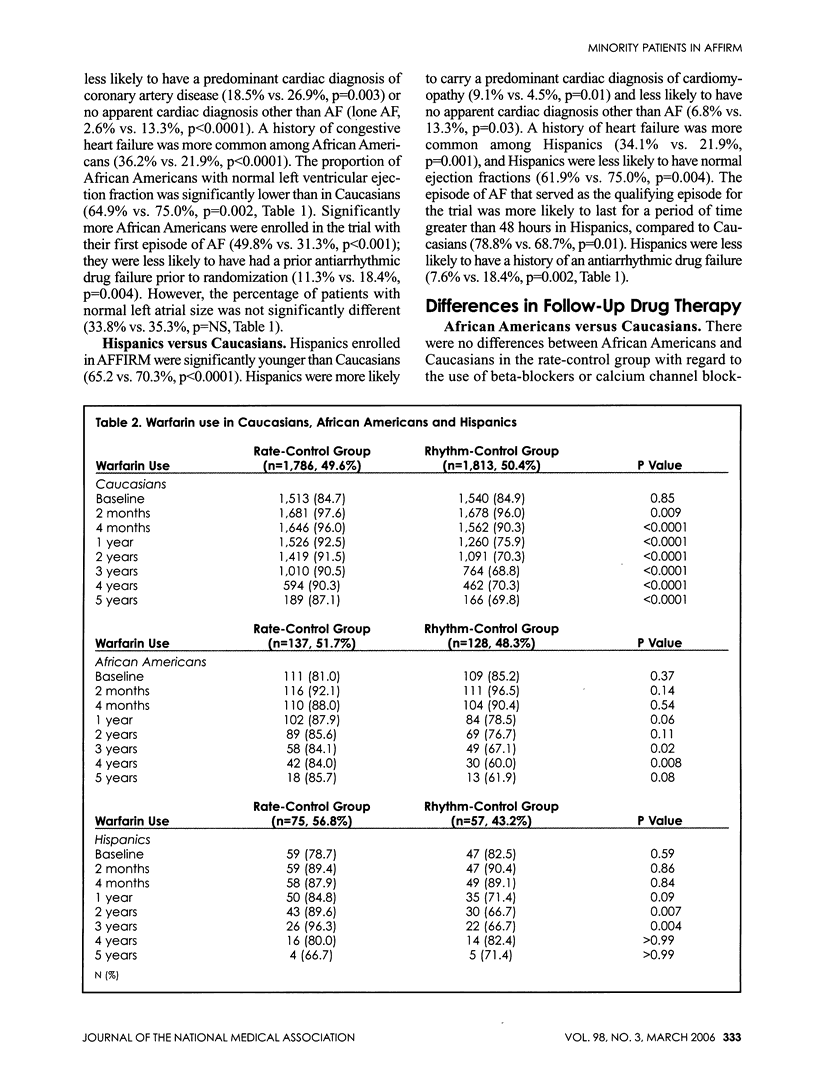

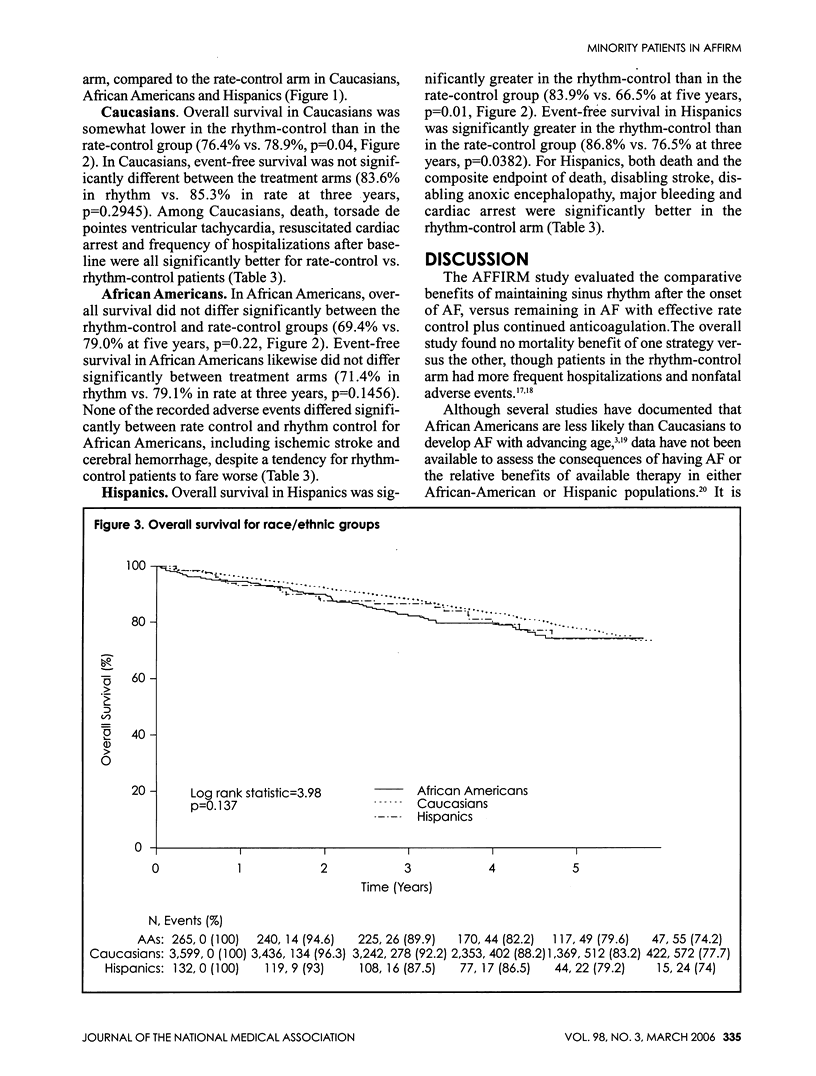
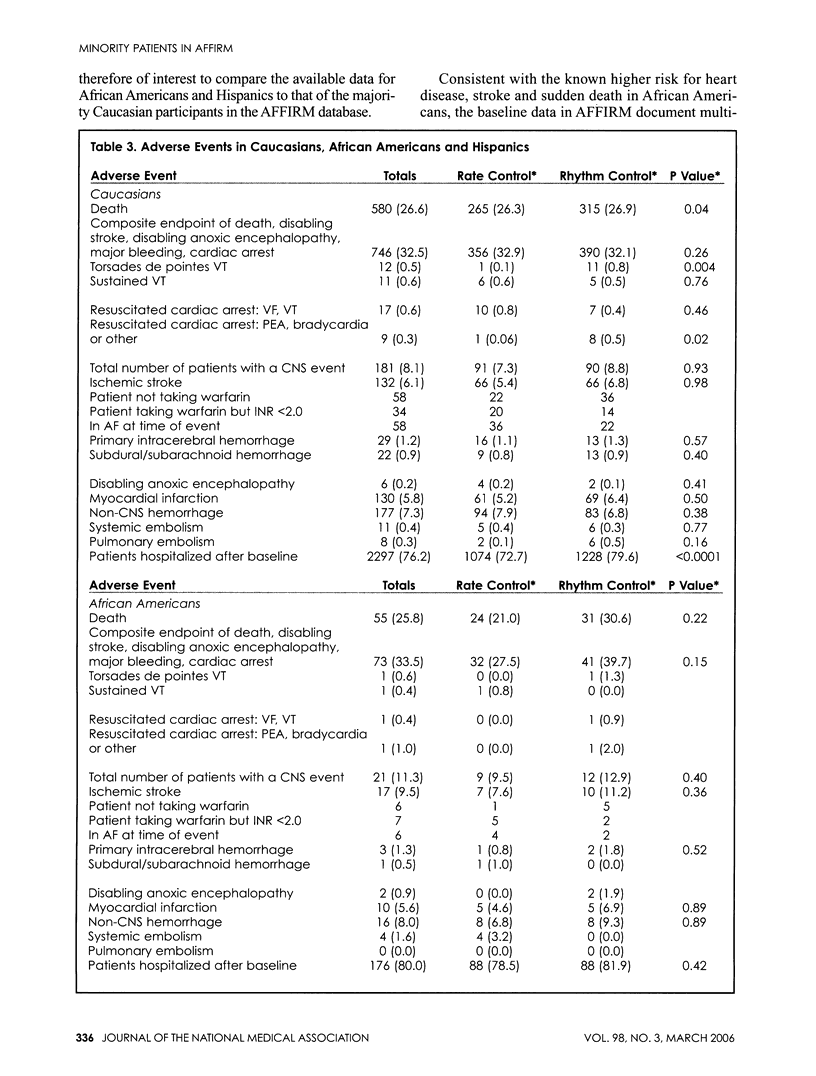
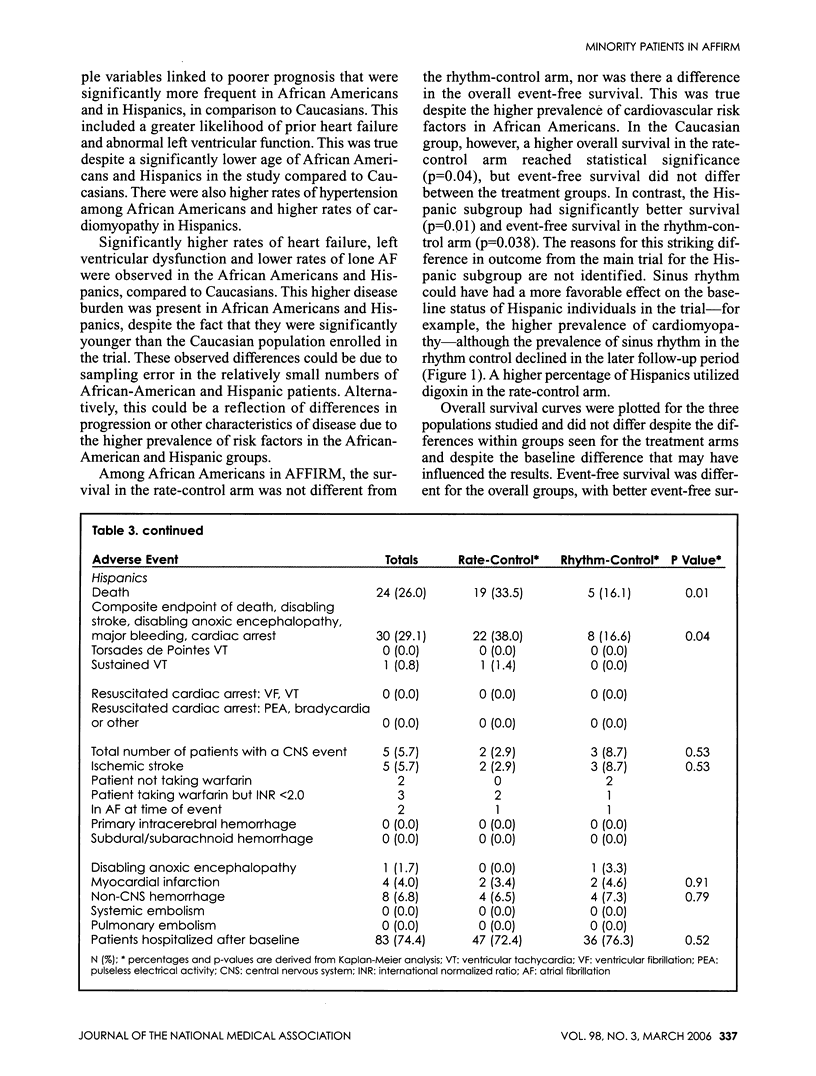
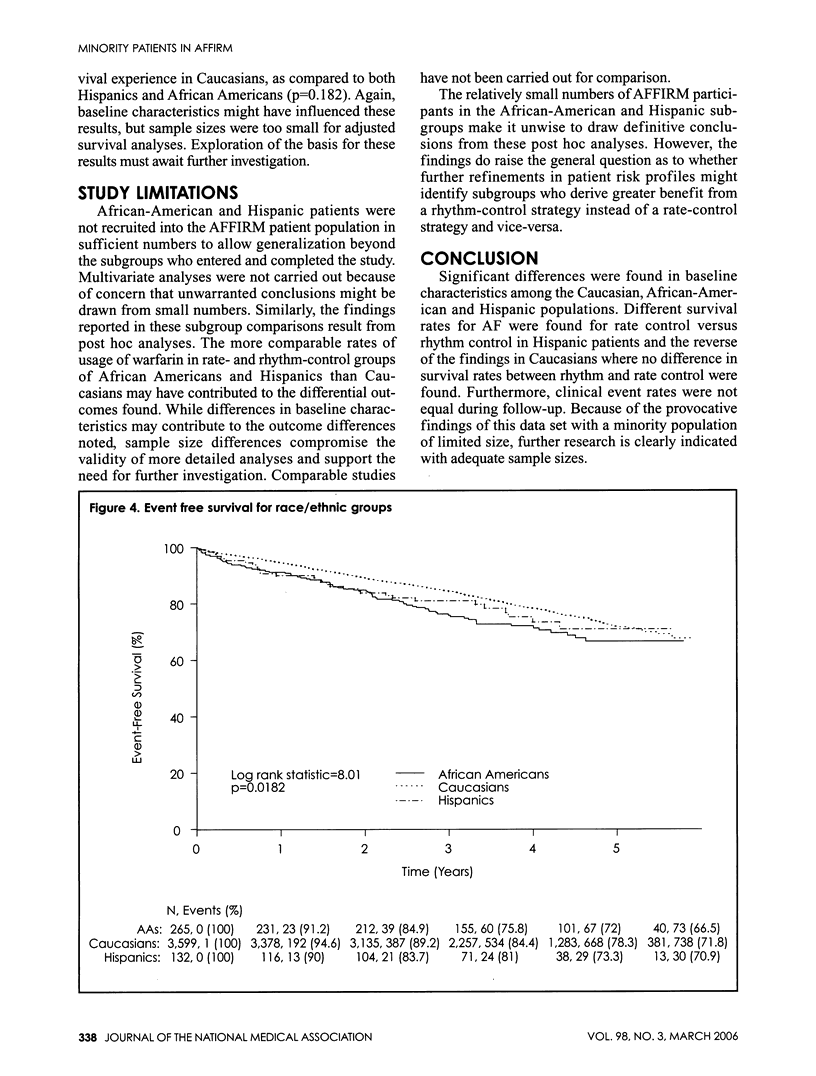
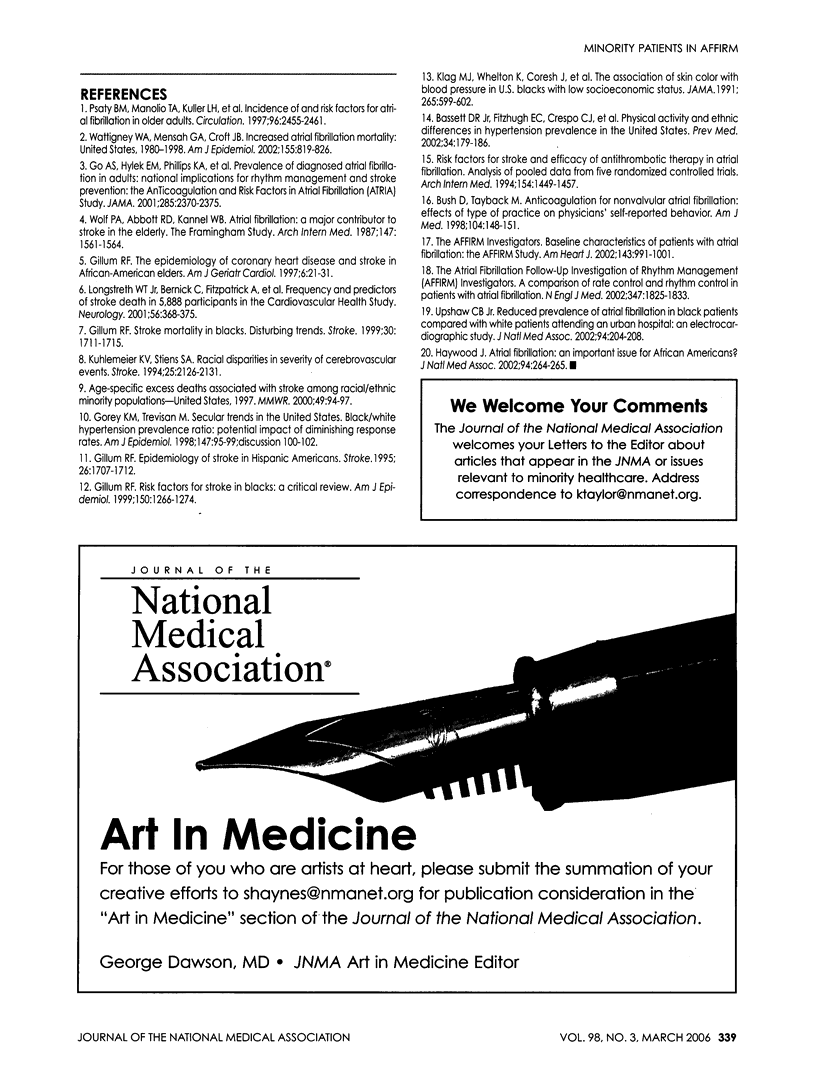
Selected References
These references are in PubMed. This may not be the complete list of references from this article.
- AFFIRM Investigators. Atrial Fibrillation Follow-up Investigation of Rhythm Management Baseline characteristics of patients with atrial fibrillation: the AFFIRM Study. Am Heart J. 2002 Jun;143(6):991–1001. doi: 10.1067/mhj.2002.122875. [DOI] [PubMed] [Google Scholar]
- Bush D., Tayback M. Anticoagulation for nonvalvular atrial fibrillation: effects of type of practice on physicians' self-reported behavior. Am J Med. 1998 Feb;104(2):148–151. doi: 10.1016/s0002-9343(97)00352-5. [DOI] [PubMed] [Google Scholar]
- Gillum R. F. Epidemiology of stroke in Hispanic Americans. Stroke. 1995 Sep;26(9):1707–1712. doi: 10.1161/01.str.26.9.1707. [DOI] [PubMed] [Google Scholar]
- Gillum R. F. Risk factors for stroke in blacks: a critical review. Am J Epidemiol. 1999 Dec 15;150(12):1266–1274. doi: 10.1093/oxfordjournals.aje.a009957. [DOI] [PubMed] [Google Scholar]
- Gillum R. F. Stroke mortality in blacks. Disturbing trends. Stroke. 1999 Aug;30(8):1711–1715. doi: 10.1161/01.str.30.8.1711. [DOI] [PubMed] [Google Scholar]
- Gillum Richard F. The Epidemiology of Coronary Heart Disease and Stroke in African-American Elders. Am J Geriatr Cardiol. 1997 Nov;6(6):21–31. [PubMed] [Google Scholar]
- Go A. S., Hylek E. M., Phillips K. A., Chang Y., Henault L. E., Selby J. V., Singer D. E. Prevalence of diagnosed atrial fibrillation in adults: national implications for rhythm management and stroke prevention: the AnTicoagulation and Risk Factors in Atrial Fibrillation (ATRIA) Study. JAMA. 2001 May 9;285(18):2370–2375. doi: 10.1001/jama.285.18.2370. [DOI] [PubMed] [Google Scholar]
- Gorey K. M., Trevisan M. Secular trends in the United States black/white hypertension prevalence ratio: potential impact of diminishing response rates. Am J Epidemiol. 1998 Jan 15;147(2):95–102. doi: 10.1093/oxfordjournals.aje.a009434. [DOI] [PubMed] [Google Scholar]
- Haywood Julian. Atrial fibrillation: an important issue for African Americans? J Natl Med Assoc. 2002 Apr;94(4):264–265. [PMC free article] [PubMed] [Google Scholar]
- Klag M. J., Whelton P. K., Coresh J., Grim C. E., Kuller L. H. The association of skin color with blood pressure in US blacks with low socioeconomic status. JAMA. 1991 Feb 6;265(5):599–602. [PubMed] [Google Scholar]
- Kuhlemeier K. V., Stiens S. A. Racial disparities in severity of cerebrovascular events. Stroke. 1994 Nov;25(11):2126–2131. doi: 10.1161/01.str.25.11.2126. [DOI] [PubMed] [Google Scholar]
- Longstreth W. T., Jr, Bernick C., Fitzpatrick A., Cushman M., Knepper L., Lima J., Furberg C. D. Frequency and predictors of stroke death in 5,888 participants in the Cardiovascular Health Study. Neurology. 2001 Feb 13;56(3):368–375. doi: 10.1212/wnl.56.3.368. [DOI] [PubMed] [Google Scholar]
- Psaty B. M., Manolio T. A., Kuller L. H., Kronmal R. A., Cushman M., Fried L. P., White R., Furberg C. D., Rautaharju P. M. Incidence of and risk factors for atrial fibrillation in older adults. Circulation. 1997 Oct 7;96(7):2455–2461. doi: 10.1161/01.cir.96.7.2455. [DOI] [PubMed] [Google Scholar]
- Rich Stuart, McLaughlin Vallerie V. Detection of subclinical cardiovascular disease: the emerging role of electron beam computed tomography. Prev Med. 2002 Jan;34(1):1–10. doi: 10.1006/pmed.2000.0813. [DOI] [PubMed] [Google Scholar]
- Upshaw Charles B., Jr Reduced prevalence of atrial fibrillation in black patients compared with white patients attending an urban hospital: an electrocardiographic study. J Natl Med Assoc. 2002 Apr;94(4):204–208. [PMC free article] [PubMed] [Google Scholar]
- Wattigney Wendy A., Mensah George A., Croft Janet B. Increased atrial fibrillation mortality: United States, 1980-1998. Am J Epidemiol. 2002 May 1;155(9):819–826. doi: 10.1093/aje/155.9.819. [DOI] [PubMed] [Google Scholar]
- Wyse D. G., Waldo A. L., DiMarco J. P., Domanski M. J., Rosenberg Y., Schron E. B., Kellen J. C., Greene H. L., Mickel M. C., Dalquist J. E. A comparison of rate control and rhythm control in patients with atrial fibrillation. N Engl J Med. 2002 Dec 5;347(23):1825–1833. doi: 10.1056/NEJMoa021328. [DOI] [PubMed] [Google Scholar]


